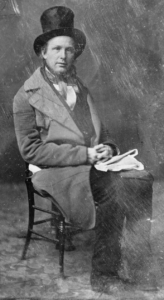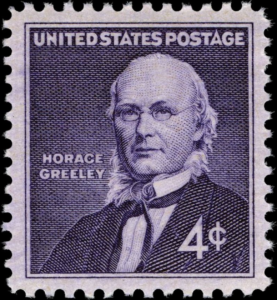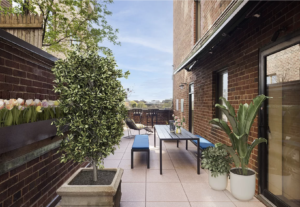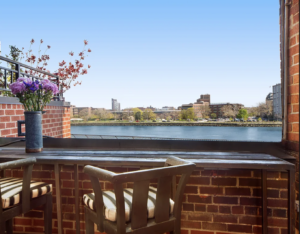In 1837, Horace Greeley (1811-1872), then founder and editor of the fledging literary magazine The New-Yorker (not related to the modern New Yorker, established in 1925 by Harold Ross and his wife, Jane Grant), wrote “Fly, scatter through the country, go to the Great West, anything rather than remain here … the West is the true destination.” A year later he reiterated this, “Go to the West: there your capabilities are sure to be appreciated and your energy and industry rewarded.” The more commonly known admonition, “Go West, young man, go west and grow up with the country,” has also been attributed to Greeley, as has “Go West, young man, go West. There is health in the country, and room away from our crowds of idlers and  imbeciles.” Greeley, a significant figure in the history of the United States, was both a fervent believer in the concept of “manifest destiny” for America as well as a powerful foe of political corruption. He founded the New York Herald Tribune, once a great national newspaper. An influential opponent of slavery and promotor of reforms still being fought for, such as feminism, vegetarianism, agrarianism and socialism, he
imbeciles.” Greeley, a significant figure in the history of the United States, was both a fervent believer in the concept of “manifest destiny” for America as well as a powerful foe of political corruption. He founded the New York Herald Tribune, once a great national newspaper. An influential opponent of slavery and promotor of reforms still being fought for, such as feminism, vegetarianism, agrarianism and socialism, he  served in the House of Representative, elected by the people of New York’s 8th district (whose Congressman now is Hakeem Jeffries, successor to Nancy Pelosi as Democratic leader in the House). Greeley also ran unsuccessfully for President in 1872, losing to Ulysses S. Grant.
served in the House of Representative, elected by the people of New York’s 8th district (whose Congressman now is Hakeem Jeffries, successor to Nancy Pelosi as Democratic leader in the House). Greeley also ran unsuccessfully for President in 1872, losing to Ulysses S. Grant.
Labelled by modern-day observers as showing traits typical of Asperger’s syndrome, Greeley’s fascinating and highly admirable life deserves more than one or two paragraphs but that’s not really the purpose of this blog. You may enjoy the excellent biography by Robert S. Williams: Horace Greeley: Champion of American Freedom.
In 1984, I followed Greeley’s advice and went West, drawn by the offer of a very attractive position as Chairman of the Department of Pathology and Laboratory Medicine at Cedars-Sinai Medical Center in Los Angeles. Although then a very fine hospital, I did not seek the position at Cedars-Sinai and knew very little about the institution.
I first learned about Cedars-Sinai approximately ten years before my 1984 move when Leo Kaplan, then co-director of the Cedars-Sinai Pathology department called to tell me he would be visiting New York and would like to discuss the medical school curriculum. At that time, there were discussions going on at Cedars-Sinai about opening a medical school (those discussions are still going on more than 50 years later …). I was responsible for the Pathology course at Mount Sinai. Leo’s son, Richard, was a medical student at Mount Sinai Medical School and had taken the Pathology course the previous year.
Leo and I agreed to spend two hours together and I, of course, prepared material to review with him. At the end of the first hour, he changed the subject and offered me a staff position in his department. I told him I wasn’t interested in leaving Mount Sinai or New York. He told me to fly out and look at the place. I responded that I wasn’t going to waste his money since I had absolutely no interest in making a change. A couple of years later he called and again offered me a staff position. Again, I declined his offer to have me fly out and visit the Cedars-Sinai.
More years zip by. I had been back (I was a resident and then was in the Navy for two years) at Mount Sinai for more than ten years and beginning to think of moving to a different New York hospital. I had been offered the position of Director at a large commercial laboratory on Long Island but, except for it being quite lucrative, it didn’t interest me and I wanted to be at a teaching institution. At a cocktail party during a meeting of one of the national pathology societies, Kate and I came across Leo and his wife, Marge. I learned that a good friend of mine had been offered the Director/Chairman position but, after a serious illness (from which he recovered completely), he withdrew his name. Leo then asked if I would be interested in the Chairmanship and I again declined. He persisted and repeated the offer to have me fly out and look at the department. This time, Kate literally jabbed her elbow into my ribs (there may still be a bruise …) and, with her irresistible smile, said, “Why don’t you just look. That won’t hurt.”
Almost two years later, after five trips to look at the department and consider the position, I began a 22-year tenure as Chairman of the Department of Pathology and Laboratory Medicine at Cedars-Sinai Medical Center, Los Angeles, joining a group of exceptional pathologists in an already excellent department. During those 22 years the workload and the number of pathologists almost doubled, as did the number of residents and fellows. In addition to expanding the volume of services we entered the world of molecular medicine, one of the first pathology departments to do so.
After stepping down from the chairmanship, I stayed on as a staff pathologist for six years. Unfortunately, my successor was ill-suited for the position and, in that time period, 30 pathologists, half of whom he recruited, left the department; I was one of the 30. A few years later he was sued by some of my former colleagues who won a judgement of more than nine million dollars, after which he left Cedars-Sinai and Los Angeles.
The years at Cedars-Sinai were mostly wonderful and the years since have been quite good. I very much miss working with young pathologists, especially residents and fellows, but I have been able to devote myself to writing novels, short stories (six published thus far) and more than 50 blogs, and even earned a Master’s in Fine Art (Writing) degree in 2018. We have been most fortunate to be able to live in Beverly Hills (in what is laughingly labelled the “poor” part of that fabled city) and also keep an apartment on East 49th Street in New York. Since leaving my life as a pathologist, Kate and I have been able to live half-year on each coast, with the exception of the pandemic year when we did not travel East.
Now, finally, a few pages into this blog, we can get to the topic.
About two years ago, after that year of COVID-induced isolation punctuated by Netflix, crossword puzzles and lots of books, and more than 35 years of missing Carnegie Hall, Nathan’s, the Met, being able to walk to dozens of different and delicious restaurants, as well as the energy and vitality of ‘the Big Apple,’ Kate said, “Why don’t we move back to New York?”
After Kate surprised me (and surprised herself!) with the suggestion, we discussed the possible move in great detail and many times. Then we started looking.
Why, as well-established octogenarians, are we moving back to New York? For me, the explanation for me is easy: I was never able to fully adjust to the Southern California life. The greatest draw in L.A. for me is the Los Angeles Philharmonic, which has become one of the very great orchestras of the world, and the Walt Disney Concert Hall whose acoustics may be matched but are unlikely to be surpassed (I am disappointed to note that the new Geffen Hall at Lincoln Center does not meet the Disney standard).
As Tony Bennett left his heart in San Francisco, I left mine in New York. A recent travel magazine has listed New York as the 3rd greatest city in the world (https://secretnyc.co/nyc-ranks-best-city-in-world/), with London and Paris edging ahead. Most New Yorkers, including me, will reflexively want to say, “Waddyamean third? Why not First.” But I love Paris and London and that ranking seems fine to me.
For years, I have joked, when asked why I love New York so much, that it’s where I know I have a blood pressure and a pulse. But it’s not really a joke. I am energized there.
In New York, in almost every neighborhood, you can easily walk to more than one good restaurant. Here, in Los Angeles, we need to drive. When we go to Lincoln Center, Carnegie Hall, or the theater, we generally walk or take a bus. To get to Disney Hall or the Ahmanson theater, we need to drive (it will be two years until an extension of the Los Angeles subway system opens in our neighborhood). We need groceries in L.A.? We actually can walk—it’s about a half-mile to two supermarkets—but what if we have a lot to carry? We drive. D’Agostino’s is a block and a half from the apartment we are buying. How much longer will we be able to drive safely? I don’t know, but I have never been a “car person,” something that is almost a requirement for life in L.A.. I distinctly remember the first cocktail party to which we were invited soon after moving to Beverly Hills. The main topics of discussion were cars, homes and the upcoming 1984 Olympic games. No politics. No world affairs. No literature. No music. Not even movies, despite being only a few miles from the Hollywood sign. In all fairness, in the almost four decades we’ve lived here, I’ve had the great pleasure of coming to know many interesting, informed, cultured people (and they’re not all former New Yorkers!) but, since I stopped going to work, interactions are not that common.
After a year and a half of searching, we identified a very nice apartment on the Upper East Side, overlooking the East River, and are now working out the details. We hoped to be settled by the time the first crocus sprouts but that may not happen. It has been a stressful search, mostly because New York apartments are almost always co-ops, rather than condos. For those of you who are not familiar with the difference, we can briefly discuss. Buying a condo is the same as buying a house. You purchase it and you move in. Just as with a house, you are responsible for all repairs. For a co-op you are buying a piece of a corporation in which your apartment sits. The co-op is responsible for most needs. Purchase requires approval by the owners’ Board of Directors, including filling out a lengthy application form in which you are required to completely disclose your financial information—copies of bank statements and investment statements, etc.—as well as provide letters of recommendation, both professional and personal (a slightly embarrassing process at my age) and, finally, undergo a face-to-face interview with the Board. We have completed the form which, a few days ago, was submitted to the building’s management company.
The completed “Boardpackager” has to be reviewed by the management company and then by the Home Owner’s Association (HOA) Board of Directors, who will ultimately interview us. Our realtor tells us we may not be able to move in until April or May.
Yikes!
These photographs are of the terrace of the apartment we are buying. Recently, I have had visions of  sitting out there with my lap-top computer working on my next novel, with
sitting out there with my lap-top computer working on my next novel, with the calm and beauty of the East River and Roosevelt Island just beyond that wall.
the calm and beauty of the East River and Roosevelt Island just beyond that wall.
One more big advantage to this move is that we will be about a mile from our daughter’s apartment after almost four decades of living far away. She can walk to our apartment and we can walk to hers. That will be a very big plus. Unfortunately, our son and grand-daughter will still be a long air flight away but we’ll have ample room for visitors.
In any event, we will be going East. More than that! We will again be New Yorkers!!
As we learned to say, when we lived in Beaufort, South Carolina, “y’all come.”
February 6, 2023 at 3:13 pm
You may count on me to visit, if you pass the inspection.
I’m happy to learn more of your career and your great fortune in your marriage.
And to have your daughter nearby is so special
Congratulations Steve
Milt
February 6, 2023 at 3:14 pm
Follow your heart and mind. Wherever y’all are, we hope you continue to have great experiences. Thanks for all you have introduced us to, the people and the places and experiences.
Good luck to you both!
Phyllis and Herbie
February 6, 2023 at 10:02 pm
Welcome home! What’s the status of the latest novel that we discussed over lunch at our last rendezvous?
February 6, 2023 at 11:02 pm
Sounds like the perfect move for you and Kate for all the reasons you describe. Glad you are following your instinct. Hope you kerp.ud updated
February 7, 2023 at 9:55 am
Welcome back to east coast. I spent 40 years working on hundreds if not thousands of n y c buildings. I certainly loved my job and loved when it came time to start a new 50 story high rise. Now I am very happy being on the very east end tip of long islands north fork during the spring/summer months. I have not been in Manhattan for 2/3 years. I personally do not miss it. The traffic, the noise, the huge crowds, the whole personality of n y is no longer for me. I used to love every minute traveling to every neighborhood and corner of the n y. But it wore me down. Now it’s winter in Florida and summers in East Marion, where my neighbors are farms and wineries. So Dr S enjoy your time in n y c and all it has to offer.
February 7, 2023 at 2:23 pm
I remember at the Mount Sinai pathology department’s send-off at the end of the 1984 academic year, Dr. Kleinerman said that one of our “young” faculty members was leaving. He was referring to you, and you burst out laughing. But you truly were young back then, even if you were already very accomplished. Now, we’re all old. My husband and I are also hoping to move back east, but probably not for another 5-10 years. Both of our children seem to be settling down in NYC, and we don’t want to grow old 3,000 miles away from them.
February 11, 2023 at 6:57 am
Progress made even easier, I suspect, with Dudamel coming to New York!
February 11, 2023 at 9:20 am
Dr Geller
Hope you have a nice time in your new apt.
Fernando
March 2, 2023 at 11:23 am
After decades of friendship with you and Kate I learned so much more Dianafrom your blog. Although theBeethoven Birthday parties gave away your love of music. Your new apartment looks like a dream. Can’t wait to visit. Love, Diana